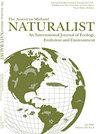An Assessment of Prairie Management Practices for Maintaining Habitat Quality for the Endangered Poweshiek Skipperling Butterfly in Canada
IF 0.6
4区 环境科学与生态学
Q4 Agricultural and Biological Sciences
引用次数: 2
Abstract
Abstract. The Poweshiek skipperling (Oarisma poweshiek) was once a common prairie butterfly in central North America, but is now critically endangered in Canada and the United States. The Poweshiek skipperling is confined to the largest remaining tall grass prairie in Canada, which is currently managed using grazing and fire to maintain prairie habitat and prevent forest and shrub encroachment. To support re-introduction, restocking, and recovery of this critically endangered species, it is necessary to understand the habitat conditions preferred by skipperlings. By surveying prairie sites with Poweshiek skipperling across age and treatment categories (1–2 y since burn, 4–6 y since burn, >15 y since burn, and grazing), we identified commonly-used nectar plants and recorded physical variables known to influence plant diversity. We measured soil variables, including macronutrients, compaction, pH, texture, and moisture content, and used multivariate statistics to test for significant differences in site characteristics and plant community across treatments. For each site, we captured plant diversity, abundance, and cover, as well as total plant biomass. We found the oldest burn sites had the fewest skipperlings. Intermediate burn sites and lightly grazed sites contained the most skipperlings. In 95% of nectaring observations, adult skipperlings were feeding on Black-eyed Susan (Rudbeckia hirta), upland white aster (Solidago ptarmicoides), and Self-heal (Prunella vulgaris). Characteristics in the physical components of sites and plant communities did not significantly differ across treatment types for most variables with the exception of the oldest burns, which showed significantly higher levels of soil compaction, live biomass, bare ground, less flowering species during the flight period, less flowering stems, and increased presence of nonnative and invasive species. Poweshiek skipperling is at high risk of imminent extirpation, and we recommend that the management regimes be adjusted to plan for a consistent supply of habitat conditions and plant species composition exemplified by our intermediate burn sites. We suggest fire return intervals of 4–6 y using patch burns in combination with grazing, permitted at times that minimize the impact on immature stages of Poweshiek skipperling. This management is needed to provide suitable habitat conditions to maintain the current population and allow for successful restocking and recovery.保护加拿大濒危跳蝶栖息地质量的草原管理措施评价
摘要Poweshiek skipperling(Oarisma Poweshiek)曾经是北美洲中部常见的草原蝴蝶,但现在在加拿大和美国处于极度濒危状态。Poweshiek船长被限制在加拿大仅存的最大的高草草原上,该草原目前通过放牧和生火来维持草原栖息地,防止森林和灌木侵占。为了支持这种极度濒危物种的重新引入、补充和恢复,有必要了解船长喜欢的栖息地条件。通过调查不同年龄和处理类别(烧伤后1-2年、烧伤后4-6年、烧伤前>15年和放牧)的Poweshiek船长的草原地点,我们确定了常用的花蜜植物,并记录了已知影响植物多样性的物理变量。我们测量了土壤变量,包括大量养分、压实度、pH值、质地和水分含量,并使用多元统计来测试不同处理的场地特征和植物群落的显著差异。对于每个地点,我们捕捉了植物多样性、丰度和覆盖率,以及植物总生物量。我们发现,最古老的烧伤地点的船长最少。中度烧伤部位和轻度擦伤部位的船长数量最多。在95%的蜜腺观察中,成年船长以黑眼苏珊(Rudbeckia hirta)、高地白紫荆(Solidago ptarmicoides)和自愈草(Prunella vulgaris)为食。对于大多数变量,不同处理类型的场地和植物群落的物理组成特征没有显著差异,但最古老的烧伤除外,其表现出显著更高的土壤压实度、活生物量、裸露地面、飞行期开花物种更少、开花茎更少,以及非本地和入侵物种的增加。Poweshiek船长面临着即将灭绝的高风险,我们建议调整管理制度,以规划栖息地条件和植物物种组成的一致供应,例如我们的中间焚烧场。我们建议采用局部烧伤和放牧相结合的方式,将火灾恢复时间间隔定为4-6年,有时允许将对Poweshiek船长未成熟阶段的影响降至最低。需要这种管理来提供合适的栖息地条件,以维持目前的种群,并允许成功地重新进货和恢复。
本文章由计算机程序翻译,如有差异,请以英文原文为准。
求助全文
约1分钟内获得全文
求助全文
来源期刊

American Midland Naturalist
环境科学-生态学
CiteScore
1.20
自引率
0.00%
发文量
38
审稿时长
18-36 weeks
期刊介绍:
The American Midland Naturalist has been published for 90 years by the University of Notre Dame. The connotations of Midland and Naturalist have broadened and its geographic coverage now includes North America with occasional articles from other continents. The old image of naturalist has changed and the journal publishes what Charles Elton aptly termed "scientific natural history" including field and experimental biology. Its significance and breadth of coverage are evident in that the American Midland Naturalist is among the most frequently cited journals in publications on ecology, mammalogy, herpetology, ornithology, ichthyology, parasitology, aquatic and invertebrate biology and other biological disciplines.
 求助内容:
求助内容: 应助结果提醒方式:
应助结果提醒方式:


